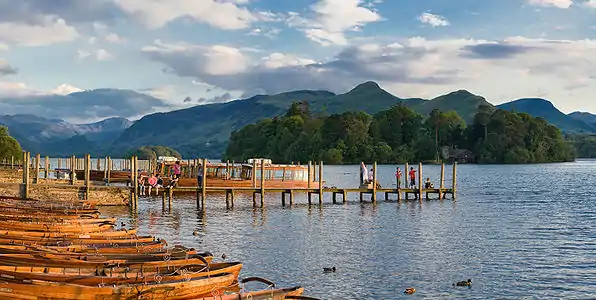Derwent Island House
Derwent Island House (often called Derwent Isle House) is a Grade II listed 18th-century Italianate house situated on the 7 acre (2.8 hectare) Derwent Island, Derwent Water, Keswick, Cumbria, and in the ownership of the National Trust. It is leased as a private home, but is open to the public five days a year. The interior is classical in style.
.jpg.webp)
History
Derwent Island was owned by Fountains Abbey and used by monks, but with the dissolution of the monasteries, it became property of the Crown in 1539. In 1569 it was sold to the Company of Mines Royal a subsidiary of a German mining company. The German miners built a camp on the island where they kept animals, grew vegetables and brewed beer.[1]
In 1778 Joseph Pocklington bought the island (then known as Vicar's Island) from Miles Ponsonby for £300. He built a house, boathouse, fort and battery, and Druid circle folly on the land. The house was one of the earliest villas to be built in the lake district, an entry in Pocklington's notebooks suggests that he saw Belle Isle in 1776, perhaps inspiring his own ambition for a house on a lake district island.[2] Pocklington held annual regattas on the lake at which he fired off his cannon and the small fort used for mock battles. Pocklington sold the island to William Peachy in 1796, a friend of poet Robert Southey.
Henry Cowper Marshall purchased the island in 1844 and employed architect Anthony Salvin to add east and west wings and a three-storey tower to the house.[3] In 1951, Mr Marshall's grandson Denis Marshall gave the property to the National Trust.
William Wordsworth
William Wordsworth was upset by the building, feeling it spoiled the view, and described Pocklington as "a native of Nottinghamshire, who played strange pranks by his buildings and plantations upon Vicar's Island, in Derwentwater, which his admiration, such as it was, of the country, and probably a wish to be a leader in a new fashion, had tempted him to purchase."[4]
Gallery (Derwent Island and Derwent Water)
Notes
- "National Trust looks for Derwent Island House tenants".
- Derwent Island House, Historic Building Recording, Matrix Archaeology
- "Keswick - Derwent Isle House". Visit Cumbria. Retrieved 6 December 2010.
- Wordsworth, "First Letter on the Keswick and Windermere Railway", 1844.
External links
- Derwent Island House - National Trust


